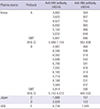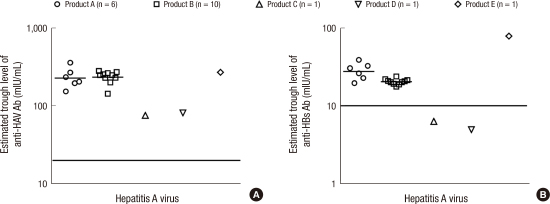1. Murphy TV, Denniston MM, Hill HA, McDonald M, Klevens MR, Elam-Evans LD, Nelson NP, Iskander J, Ward JD. Progress toward eliminating hepatitis A disease in the United States. MMWR Suppl. 2016; 65:29–41.
2. Ogholikhan S, Schwarz KB. Hepatitis vaccines. Vaccines (Basel). 2016; 4:E6.
3. Jacobsen KH, Wiersma ST. Hepatitis A virus seroprevalence by age and world region, 1990 and 2005. Vaccine. 2010; 28:6653–6657.
5. Ciocca M. Clinical course and consequences of hepatitis A infection. Vaccine. 2000; 18:Suppl 1. S71–4.
6. Trépo C, Chan HL, Lok A. Hepatitis B virus infection. Lancet. 2014; 384:2053–2063.
8. Jacobsen KH, Koopman JS. Declining hepatitis A seroprevalence: a global review and analysis. Epidemiol Infect. 2004; 132:1005–1022.
9. Pedersini R, Marano C, De Moerlooze L, Chen L, Vietri J. HAV & HBV vaccination among travellers participating in the National Health and Wellness Survey in five European countries. Travel Med Infect Dis. 2016; 14:221–232.
10. Leder K, Chen LH, Wilson ME. Aggregate travel vs. single trip assessment: arguments for cumulative risk analysis. Vaccine. 2012; 30:2600–2604.
11. Steffen R, Behrens RH, Hill DR, Greenaway C, Leder K. Vaccine-preventable travel health risks: what is the evidence--what are the gaps? J Travel Med. 2015; 22:1–12.
12. Keller MA, Stiehm ER. Passive immunity in prevention and treatment of infectious diseases. Clin Microbiol Rev. 2000; 13:602–614.
13. Joanna G, Slawomir Z, Barbara R, Barbara R. Does the proper intravenous immunoglobulin substitution in primary immunodeficiency protect against HBV infections?: a description of a case series. Med Microbiol Immunol (Berl). 2008; 197:325–328.
14. Fried AJ, Bonilla FA. Pathogenesis, diagnosis, and management of primary antibody deficiencies and infections. Clin Microbiol Rev. 2009; 22:396–414.
15. Soler-Palacín P, Gasó-Gago I, Fernández-Polo A, Martín-Nalda A, Oliveras M, Martinez-Cutillas J, Figueras C. Intravenous and subcutaneous immunoglobulin replacement: a two-way road. Optimizing healthcare quality in patients with primary immunodeficiencies. J Clin Immunol. 2014; 34:1015–1017.
16. Aguilar C, Malphettes M, Donadieu J, Chandesris O, Coignard-Biehler H, Catherinot E, Pellier I, Stephan JL, Le Moing V, Barlogis V, et al. Prevention of infections during primary immunodeficiency. Clin Infect Dis. 2014; 59:1462–1470.
17. Albin S, Cunningham-Rundles C. An update on the use of immunoglobulin for the treatment of immunodeficiency disorders. Immunotherapy. 2014; 6:1113–1126.
18. Bonagura VR, Marchlewski R, Cox A, Rosenthal DW. Biologic IgG level in primary immunodeficiency disease: the IgG level that protects against recurrent infection. J Allergy Clin Immunol. 2008; 122:210–212.
19. Fiore AE, Wasley A, Bell BP; Advisory Committee on Immunization Practices (ACIP). Prevention of hepatitis A through active or passive immunization: recommendations of the Advisory Committee on Immunization Practices (ACIP). MMWR Recomm Rep. 2006; 55:1–23.
20. Mast EE, Weinbaum CM, Fiore AE, Alter MJ, Bell BP, Finelli L, Rodewald LE, Douglas JM Jr, Janssen RS, Ward JW, et al. A comprehensive immunization strategy to eliminate transmission of hepatitis B virus infection in the United States: recommendations of the Advisory Committee on Immunization Practices (ACIP) Part II: immunization of adults. MMWR Recomm Rep. 2006; 55:1–33.
21. Haverkate M, D’Ancona F, Giambi C, Johansen K, Lopalco PL, Cozza V, Appelgren E. VENICE project gatekeepers and contact points. Mandatory and recommended vaccination in the EU, Iceland and Norway: results of the VENICE 2010 survey on the ways of implementing national vaccination programmes. Euro Surveill. 2012; 17:20183.
22. Farcet MR, Planitzer CB, Stein O, Modrof J, Kreil TR. Hepatitis A virus antibodies in immunoglobulin preparations. J Allergy Clin Immunol. 2010; 125:198–202.
24. Radosevich M, Burnouf T. Intravenous immunoglobulin G: trends in production methods, quality control and quality assurance. Vox Sang. 2010; 98:12–28.
25. Moon S, Han JH, Bae GR, Cho E, Kim B. Hepatitis A in Korea from 2011 to 2013: current epidemiologic status and regional distribution. J Korean Med Sci. 2016; 31:67–72.
26. Lee H, Cho HK, Kim JH, Kim KH. Seroepidemiology of hepatitis A in Korea: changes over the past 30 years. J Korean Med Sci. 2011; 26:791–796.
27. Lee D, Ki M, Lee A, Lee KR, Park HB, Kim CS, Yoon BY, Kim JH, Lee YS, Jeong SH. A nationwide seroprevalence of total antibody to hepatitis A virus from 2005 to 2009: age and area-adjusted prevalence rates. Korean J Hepatol. 2011; 17:44–50.
28. Kiyohara T, Sato T, Totsuka A, Miyamura T, Ito T, Yoneyama T. Shifting seroepidemiology of hepatitis A in Japan, 1973-2003. Microbiol Immunol. 2007; 51:185–191.
29. Furusyo N, Hayashi J, Sawayama Y, Kawakami Y, Kishihara Y, Kashiwagi S. The elimination of hepatitis B virus infection: changing seroepidemiology of hepatitis A and B virus infection in Okinawa, Japan over a 26-year period. Am J Trop Med Hyg. 1998; 59:693–698.
30. Klevens RM, Kruszon-Moran D, Wasley A, Gallagher K, McQuillan GM, Kuhnert W, Teshale EH, Drobeniuc J, Bell BP. Seroprevalence of hepatitis A virus antibodies in the U.S.: results from the National Health and Nutrition Examination Survey. Public Health Rep. 2011; 126:522–532.
31. Wasley A, Samandari T, Bell BP. Incidence of hepatitis A in the United States in the era of vaccination. JAMA. 2005; 294:194–201.
32. Wu CY, Wang HC, Wang KT, Yang-Chih Shih D, Lo CF, Wang DY. Analyzing titers of antibodies against bacterial and viral antigens, and bacterial toxoids in the intravenous immunoglobulins utilized in Taiwan. Biologicals. 2013; 41:88–92.
33. Daily J, Werner B, Soiffer R, Fingeroth J. IGIV: a potential role for hepatitis B prophylaxis in the bone marrow peritransplant period. Bone Marrow Transplant. 1998; 21:739–742.
34. U.S. Centers for Disease Control and Prevention. Hepatitis B virus: a comprehensive strategy for eliminating transmission in the United States through universal childhood vaccination. Recommendations of the Immunization Practices Advisory Committee (ACIP). MMWR Recomm Rep. 1991; 40:1–25.
35. Kim H, Lee KS, Chang SH, Park S, Kim C, Lee CH, Kweon HJ, Chung SS. Sero-prevalence of hepatitis B virus surface antigen and antibody in high school students in Chungju-city. Korean J Epidemiol. 2002; 24:107–112.
36. Kang CI, Choi CM, Park TS, Lee DJ, Oh MD, Choe KW. Incidence and seroprevalence of hepatitis A virus infections among young Korean soldiers. J Korean Med Sci. 2007; 22:546–548.
37. Wasley A, Kruszon-Moran D, Kuhnert W, Simard EP, Finelli L, McQuillan G, Bell B. The prevalence of hepatitis B virus infection in the United States in the era of vaccination. J Infect Dis. 2010; 202:192–201.
38. Akbar SM, Onji M, Kanaoka M, Horiike N, Michitaka K, Masumoto T, Nonaka T, Kanda K, Kajino K, Kumamoto I, et al. The seroepidemiology of hepatitis A and B in a Japanese town. Asia Pac J Public Health. 1992–1993; 6:26–29.
39. Schroeder HW Jr, Dougherty CJ. Review of intravenous immunoglobulin replacement therapy trials for primary humoral immunodeficiency patients. Infection. 2012; 40:601–611.






 PDF
PDF ePub
ePub Citation
Citation Print
Print




 XML Download
XML Download